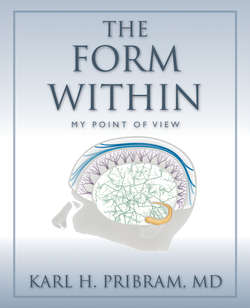Читать книгу The Form Within - Karl H Pribram - Страница 36
На сайте Литреса книга снята с продажи.
Mapping the Neuro-Nodal Web
ОглавлениеAt about the same time, in the 1950s, that Hodgkin had begun his work on the retina, I shared a panel at a conference held in 1954 at MIT with Stephen Kuffler of the Johns Hopkins University. In his presentation, Kuffler declared that the “All or None Law” of the conduction of nerve impulses had to be modified into an “All or Something Law”: That the amplitude and speed of conduction of a nerve impulse is proportional to the diameter of the nerve fiber. Thus the speed of conduction and size of a nerve impulse at the fine-fibered presynaptic termination of axon branches (as well as in the fine-fibered postsynaptic dendrites) is markedly reduced, necessitating chemical boosters to make connections (or a specialized tight junction to make an ephaptic electrical connection).
Kuffler focused my thinking on the type of processing going on in the fine-fibered webs of the nervous system, a type of processing that has been largely ignored by neuro-scientists, psychologists and philosophers.
Kuffler went further: he devised a technique that allowed us, for the first time, to map what is going on in these fine-fibered webs of dendrites in the retina and the brain. Kuffler noted that in the clinic, when we test a person’s vision, one of our procedures is to map his visual field by having him tell us where a spot of light is located. The visual field is defined as that part of the environment that we can see with a single eye without moving that eye. When we map the shape of the field for each eye, we can detect changes due to such things as retinal pathology, pituitary tumors impinging on the place where the optic nerves cross, strokes, or other disturbances of the brain’s visual pathways.
Kuffler realized that, instead of having patients tell us when and where they see a spot, we could—even in an anesthetized animal—let their neurons tell us. The signal we use to identify whether a neuron recognizes the spot is the change in pattern of nerve impulses generated in an axon. The “receptive field” of this axon is formed by its finefibered branches and corresponds precisely, for the axon, to what the “visual field” is for a person. By this procedure, the maps we obtain of the axon’s dendritic receptive field vary from brain cell to brain cell, depending upon what kind of stimulus (e.g., a spot, a line, a grating) we use in order to elicit the response: as in the case of whole brain maps, the patterns revealed by mapping depend on the procedure we use to display the micro-maps.
Kuffler’s initial work with receptive fields, followed by that of others in laboratories in Sweden and then all over the world, established that the receptive fields of those axons originating in the retina appear like a bull’s-eye: some of the retina’s receptive fields had an excitatory (“on”) center, while others had an inhibitory (“off”) center, each producing a “complementary” surrounding circular band.
When he used color stimuli, the centers of those receptive fields which were formed by a response to one specific color—for instance, red—were surrounded by a ring that was sensitive to its complementary (also called its opponent) color—in the case of red: green; centers responding to yellow were surrounded by rings sensitive to blue, and so forth. Having written my medical student’s thesis on the topic of retinal processing of color stimuli, I remember my excitement in hearing of Kuffler’s experimental results. For the first time this made it possible for us to establish a simple classification of retinal processing of color and to begin to construct a model of the brain’s role in organizing color perception.
In addition, we learned that in more central parts of the brain’s visual system, in the halfway house of the paths from the retina to the cortex—the thalamus (“chamber,” in Latin)—the receptive field maps have more rings, each ring alternating, as before, between excitation and inhibition— or between complementary colors.
However, in initial trials at the brain’s cortex, the technique of moving a spot in front of an eye at first failed to produce any consistent response. It took an accident, a light somewhat out of focus, to produce an elongated stimulus, to provide excellent and interesting responses: neurons were selective of the orientation of the stimulus; that is, different orientations of the elongated “line” stimulus activated different neurons.
Furthermore, for those neurons that responded, the map of the receptive field became elongated, with some fields having inhibitory “flanks,” like elongated rings of the bulls-eye, while others without such flanks looked more like flat planes. We’ve all learned in high school geometry that by putting together points we can make lines and putting together lines at various orientations we can compose stick figures and planes. Perhaps, thought the scientists, those brain processes that involve our perceptions also operate according to the rules of geometry that we all had learned in school.
The scientific community became very excited by this prospect, but this interpretation of our visual process in terms of shape, as is the case with regard to brain maps, though easy to understand, fails to explain many aspects of the relationship of our brain to our experience.
In time, another interpretation, which I shall explore in the next chapters of The Form Within, would uncover the patterns underlying these shapes. A group of laboratories, including mine, would provide us a more encompassing view of processing percepts and acts by the brain.
